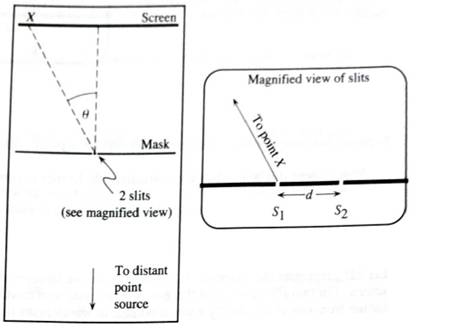
Concept explainers
Red light from a distant point source is incident on two very narrow identical slits,

The magnified view shows the path from slit
On the magnified view:
• Draw an arrow to show the direction fromslit
• Identified and label the line segment of length

Want to see the full answer?
Check out a sample textbook solution
Chapter 11 Solutions
Tutorials in Introductory Physics
Additional Science Textbook Solutions
Sears And Zemansky's University Physics With Modern Physics
The Cosmic Perspective (8th Edition)
Physics: Principles with Applications
Physics (5th Edition)
University Physics Volume 1
Life in the Universe (4th Edition)
- Discuss the two cases, constructive and destructive interferences, as a result of thin-film interference. (Provide figure/s to support your statement.)arrow_forwardA radio transmitting station operating at a frequency of 125 MHz has two identical antennas that radiate in phase. Antenna B is 9.00 m to the right of antenna A. Consider point P between the antennas and along the line connecting them, a horizontal distance x to the right of the antenna. For what values of x will constructive interference occur at point P? Express your answers in meters and in ascending order separated by comas.arrow_forwardAn array of 100 slits per millimetre is illuminated with light made up of a mixture of 3 wavelengths: a shade of violet, a shade of green and a shade of red. On a screen 2 meters away, we see the figure shown in the diagram below. Determine as precisely as possible the wavelength of each color.arrow_forward
- Solve the following: (show your complete solution) (a) At what angle is the first minimum for 550-nm light falling on a single slit of width 1.00 µm? (b) Will there be a second minimum?arrow_forwardThe diffraction pattern below arises from a single slit. If we would like to sharpen the pattern (i.e., make the central bright spot narrower), what should we do to the slit width? a) widen the slit b) enlarge the screen c) close off the slit d) None of the other responses are correct.arrow_forwardConsider a single slit that produces its first minimum for 630 nm light at an angle of 26 degrees Part a: How wide is the single slit in meters? Part b: at what angle ( in degrees) will the second be minimumarrow_forward
- Consider the interference pattern at the right. (The crests are represented by thick lines and the troughs by thin lines.) The distance from S1 to point D is 47.2 cm. What is the wavelength? What is the distance from S2 to point D?arrow_forwardSolve the two double-slit equations above for λ in terms of the measurable quantities d, y, m, and L. You may use the small angle approximation: sin θ ≈ tan θ.arrow_forwardplease explain mathematically(using equations) when the number of slits increases, what happens to the diffraction patternarrow_forward
- While researching the use of laser pointers, you conduct a diffraction experiment with two thin parallel slits. Your result is the pattern of closely spaced bright and dark fringes shown in (Figure 1) (Only the central portion of the pattern is shown.) You measure that the bright spots are equally spaced at 1.53 mm center to center (except for the missing spots) on a screen that is 2.50 m from the slits. The light source was a helium–neon laser producing a wavelength of 632.8 nm. How far apart are the two slits? How wide is each slit?arrow_forwardSpeakers A and B are in a straight line with a person (P) with the closer speaker B located 2m from her and speaker A located 3 meters away from her as shown. What is the longest wavelength from which there will be destructive interference at P.arrow_forwardA narrow beam of white light enters a prism made of crown glass at a 45° incident angle, as shown in attached figure 1. At what angles, θR and θV, do the red (660 nm) and violet (410 nm) components of the light emerge from the prism? Feel free to use the table attached for the indices of refraction as a function of wavelength. How would I derive the outgoing angle as a function of the incoming angle and the index of refraction. As I am struggling with this question, any help would be greatly appreciated :)arrow_forward
 Physics for Scientists and Engineers: Foundations...PhysicsISBN:9781133939146Author:Katz, Debora M.Publisher:Cengage Learning
Physics for Scientists and Engineers: Foundations...PhysicsISBN:9781133939146Author:Katz, Debora M.Publisher:Cengage Learning Glencoe Physics: Principles and Problems, Student...PhysicsISBN:9780078807213Author:Paul W. ZitzewitzPublisher:Glencoe/McGraw-Hill
Glencoe Physics: Principles and Problems, Student...PhysicsISBN:9780078807213Author:Paul W. ZitzewitzPublisher:Glencoe/McGraw-Hill

